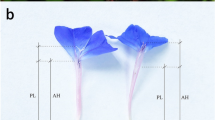Summary
Because previous attempts to produce interspecific hybrids between different Panicum species were unsuccessful, we undertook this study to investigate the impediments to hybridization. Accessions of P. antidotale Retz. (blue panicgrass), P. coloratum L. (kleingrass), and P. deustum Thunb. were self-pollinated and also crossed with one another. Following pollination, pollen germination and tube growth were studied in vivo by observing the pollinated pistils with fluorescence microscopy. Examination of the self-pollinated pistils revealed that pollen germination was approximately 90% for each species and germination occurred shortly after pollination. Pollen tubes grew to the micropyle within one hour after pollination in kleingrass and two hours in blue panicgrass and P. deustum. One P. deustum accession (PI 364953) was self-incompatible with pollen tube inhibition occurring in the style. In the cross-pollinations, the pollen also germinated shortly after pollination, and the overall germination ranged from 77 to 88% for the different crosses. In crosses between kleingrass and P. deustum, most pollen tube growth was arrested shortly after penetration of the stigma papilla, but a limited number of tubes grew to different locations within the stigma. Only four reached the upper part of the style. In crosses between blue panicgrass and P. deustum, the pollen tubes failed to grow beyond the stigma except in one cross where they grew into the upper half of the style. In the blue panicgrass x kleingrass crosses, the tubes grew into the style but were arrested before entering the ovary. In the reciprocal cross the tubes grew into the ovary, but the tubes became disoriented and grew in an apparently random manner, never penetrating the micropyle. Thus, cross-incompatibility systems are responsible for the failure to produce hybrids among these Panicum species.
Similar content being viewed by others
References
Hayman, D. L., 1956. The genetic control of incompatibility in Phalaris coerulescens. Aust. J. Biol. Sci. 9: 321–331.
Heslop-Harrison, J., 1982. Pollen-stigma interaction and cross-incompatibility in the grasses. Science 215: 1358–1364.
Kho, Y. O. & J. Baer, 1968. Observing pollen tubes by means of fluorescence. Euphytica 17: 298–302.
Kho, Y. O. & J. Baer, 1970. A microscopial research on the incompatibility in the cross Rhododendron impeditum x R. williamsianum. Euphytica 19: 303–309.
Lundqvist, A., 1956. Self-incompatibility in rye. I. Genetic control in the diploid. Hereditas 42: 293–348.
Nettancourt, D.de, 1977. Incompatibility in Angiosperms. Springer-Verlag, Berlin, Heidelberg, New York.
Author information
Authors and Affiliations
Additional information
Incooperation with the Texas Agricultural Experiment Station. Texas A & M University.
Rights and permissions
About this article
Cite this article
Burson, B.L., Young, B.A. Pollen-pistil interactions and interspecific-incompatibility among Panicum antidotale, P. coloratum, and P. deustum . Euphytica 32, 397–405 (1983). https://doi.org/10.1007/BF00021448
Received:
Issue Date:
DOI: https://doi.org/10.1007/BF00021448




